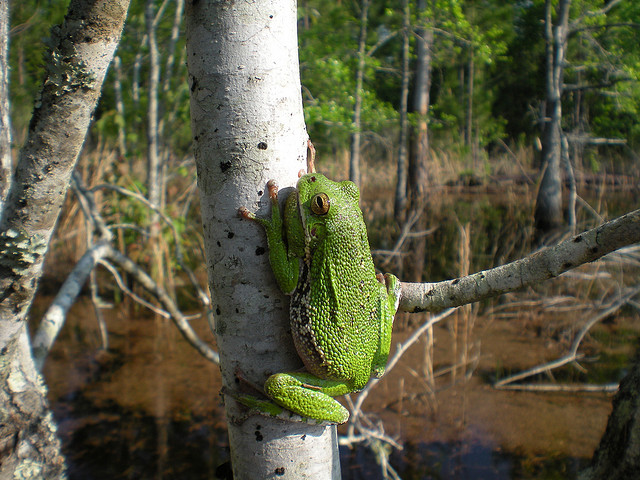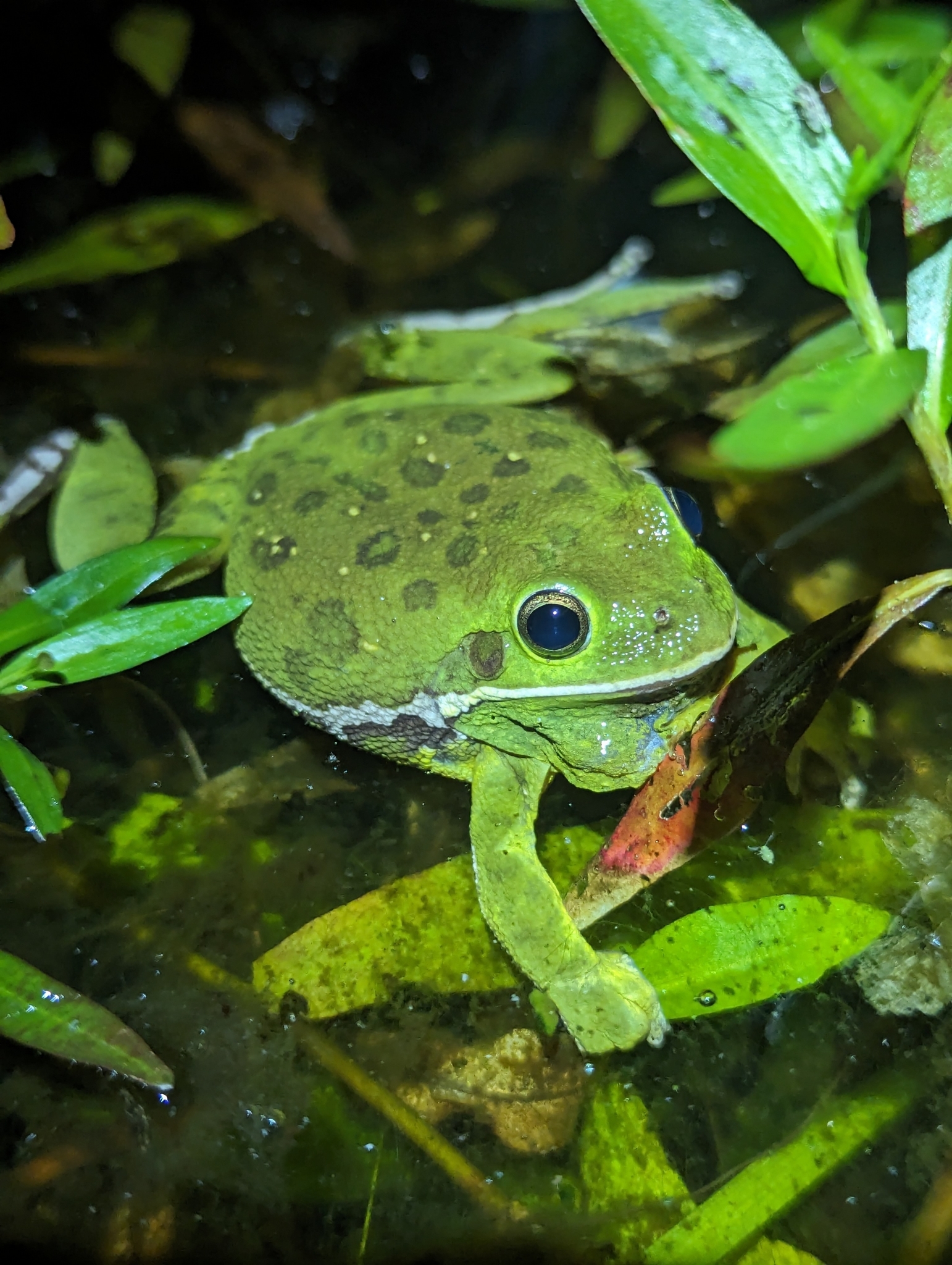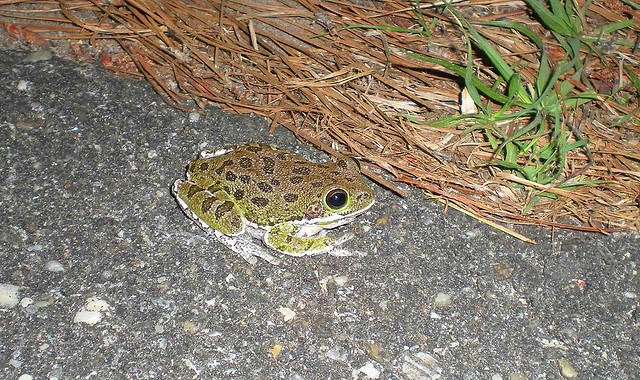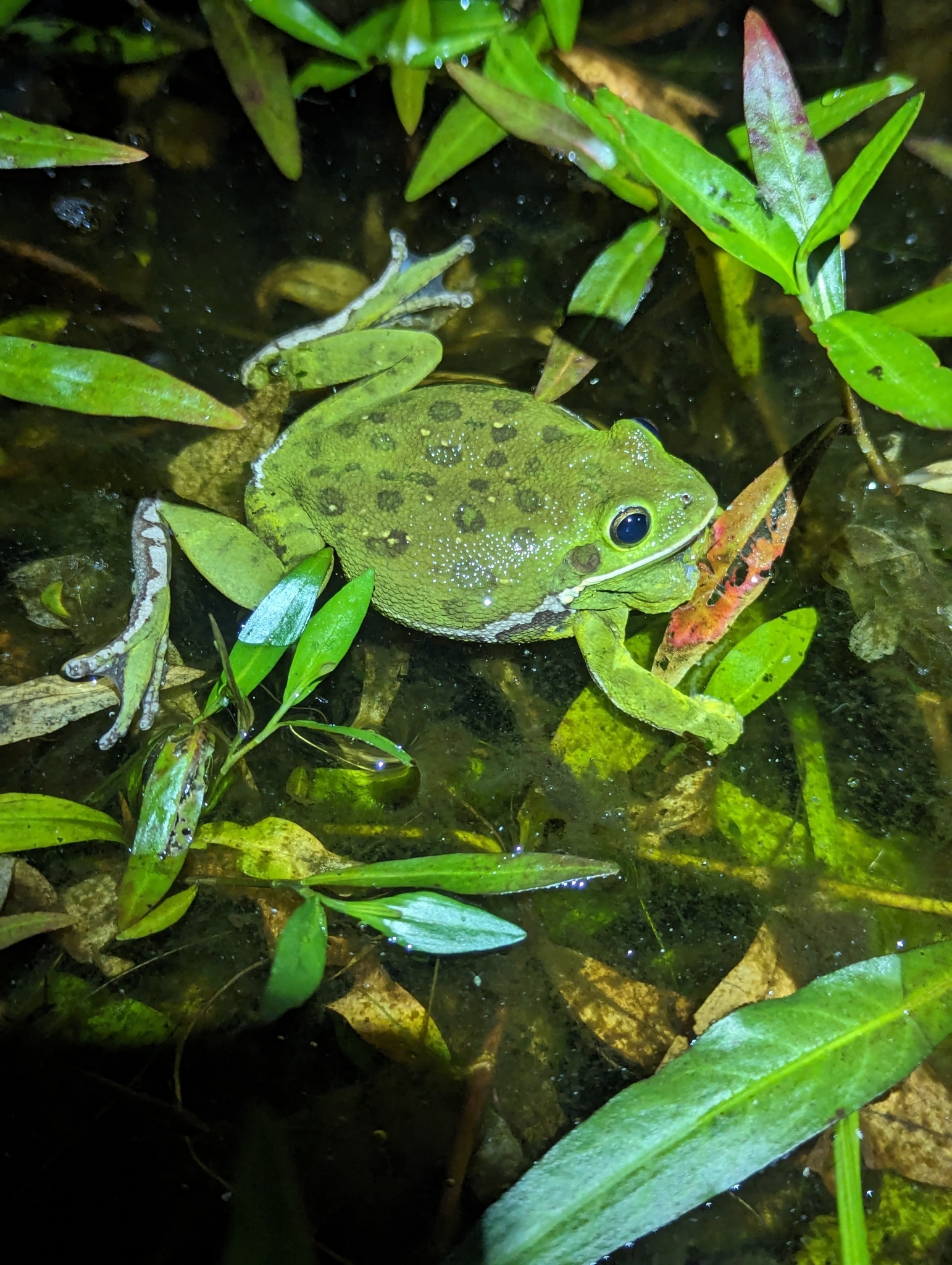Map Snapshot




15 Records
Barking Treefrog in Kent Co., Maryland (Date obscured). (c) Cole Tiemann, some rights reserved (CC BY-NC). - Cole Tiemann via iNaturalist.
Status
Barking Treefrog (Hyla gratiosa) is a large treefrog species, discovered in Maryland in 1982, and currently known from only three coastal plain counties (Kent, Queen Anne's, and Caroline). It is ranked as S1 (highly state rare), and is considered state-endangered and vulnerable (Maryland DNR site). It breeds in vernal pools, ponds, and bays, and spends much time in sandy forest, where they will sometimes burrow in dry weather. This species is quite large for a treefrog, squat and stocky, with a granular skin texture, and round spots on a pale green body, plus large adhesive foot pads, befitting its arboreal habits. One vocalization is a hoarse, repeated barking, uttered from trees. There is another call given at breeding habitat, a loud, abrupt 'toonk' which it repeats every few seconds (Conant & Collins, 1998; Maryland DNR site).
Seasonality Snapshot
Source: Wikipedia
| Barking tree frog | |
|---|---|

| |
| Scientific classification | |
| Domain: | Eukaryota |
| Kingdom: | Animalia |
| Phylum: | Chordata |
| Class: | Amphibia |
| Order: | Anura |
| Family: | Hylidae |
| Genus: | Dryophytes |
| Species: | D. gratiosus
|
| Binomial name | |
| Dryophytes gratiosus (LeConte, 1856)
| |
| Synonyms | |
| |

Dryophytes gratiosus, commonly known as the barking tree frog, is a species of tree frog endemic to the south-eastern United States. Formerly known as Hyla gratiosa.[2]
Geographic range
[edit]
It is found from Delaware to southern Florida and eastern Louisiana, usually in coastal areas. There are also some isolated colonies in Maryland, Kentucky, and Tennessee. A temporary population was found in New Jersey in 1957.[3]
Description
[edit]Dryophytes gratiosus is the largest native tree frog in the United States, acquiring its name from the raucous and explosive call.[4] It is 5 to 7 cm (2.0 to 2.8 in) in head-body length.[5] It is variable in color, but easily recognizable due to the characteristic dark, round markings on its dorsum. Individuals may be bright or dull green, brown, yellowish, or gray in color with small, grey and green-yellow spots. It has prominent, round toe pads, and the male has a large vocal sac. Dryophytes gratiosus has skin that is unlike any other species of American frog.[4] Its skin is neither rough and warty nor smooth, having skin that is thick and leathery. Its skin can also shift colors depending on lighting, time of day, temperature, or its surroundings.[5] Changes in color can be rapid and the spots can seem to disappear and reappear over time.[4] The eyes of Dryophytes gratiosus are brown, gold, and black.
Behavior
[edit]

The barking tree frog is known for its loud, strident, barking call. It may also utter a repetitive single-syllable mating call. The calls of the barking tree frog sound like a church bell and have been described as "tonk" and "doonk".[6] It has been known to chorus with other frogs of the same and similar species. Furthermore, during mating, a female D. gratiosus is more likely to pick an attractive mating call unless if it is more than five meters away.[7] Male mating success is positively correlated with chorus attendance however limitations from energy costs reduce the length of time that the males will call in chorus. They slowly become in poorer condition until they either die or leave the pond to replenish their energy requirements.[8]
The barking tree frog burrows in the sand, especially when the temperature is hot. It also spends time high up in trees, especially during the day when it is less active.
Habitat
[edit]Adult Dryophytes gratiosus usually live in trees or bushes. They can also burrow deep into mud and logs for added protection from predators. [9] Barking treefrogs need shallow, semi-permanent pools with open canopies or ponds dominated by grasses, which have at least some open water for suitable breeding habitat.[10]
Movement
[edit]Male barking tree frogs will move down from the treetops and make their way to a nearby pond in the evenings.[11] This movement is associated with the need to breed, and females soon make their way to the pond as well. After breeding has taken place, barking tree frogs will go back to the forest to occupy the trees. The barking treefrog has the ability to travel long distances if they are not successful in finding a mate in one wetland, but for the most part they stay in the same general area and only really move during the mating season.[12]
Breeding
[edit]Dryophytes gratiosus is a polygynous species, the female choosing the male on the basis of his call. They use multiple call characteristics concurrently to select a mate and can be quite choosy.[13] One study researched that for the males to win over a female, the males will arrive at the breeding ponds earlier in the night. The study goes on to present forth the evidence that the males who arrive earlier have a higher probability of mating than the males that arrived late.[14] Females however will generally use call amplitude and frequency to select a mate, as these characteristics correlate to body size.[15] So females do look at the duration as well as call rate when picking a mate, and it isn’t just as simple as whoever has the longer call or calls more frequently.[16] Females will choose the right mate with greater amplitude. These females will use triangulation. Triangulation is used to find a male's location by his call, finding others around the male, and to assess the distance between them.[17] Males remain still while calling until the female initiates amplexus by nudging the male.[18] The barking tree frog, reproduces aquatically but migrates to land to lay their eggs. Breeding typically occurs over two or three months, the months differing depending on the location. In Kentucky, Dryophytes gratiosus usually breads between mid June to late July, April to July in North Carolina and Alabama, and March to August in Louisiana and Florida.[19] Most male Dryophytes gratiosus have been reported calling in an inflated condition at the surface of shallow water, usually among aquatic vegetation.[20] After mating, both sexes move inland to higher grasses. Females lay anywhere from 1,500 and 4,000 eggs at a time.[19] When these eggs hatch, grow into tadpoles, or the tailed larva of an amphibian. Tadpoles can be nearly 5 cm (2.0 in) in length.
Speciation
[edit]Sometimes people get the Barking Treefrog and the American Green Treefrog confused morphologically as well as acoustically,[21] and one study recorded occasional hybridization with Dryophytes cinereus.[22] Though the two species are genetically compatible enough to mate, the hybrids they produce are at a disadvantage.[23] The hybrids of barking treefrogs and green treefrogs are usually less fit and are not normally chosen by non-hybrid females of either species for mating.
Conservation status
[edit]According to the ICUN Red List, Dryophytes gratiosus is of the status of Least Concern as of March 2019.[24]
Species Concerns
[edit]Through research studies it was learned that agriculture landscapes show the biggest threats to this species and amphibians in general, and juvenile amphibians feel the worst of the effects of the agricultural industry.[25]
References
[edit]- ^ IUCN SSC Amphibian Specialist Group (2017). "Dryophytes gratiosus". IUCN Red List of Threatened Species. 2017: e.T55495A112714049. doi:10.2305/IUCN.UK.2017-1.RLTS.T55495A112714049.en. Retrieved 18 November 2021.
- ^ Duellman, William E.; Marion, Angela B.; Hedges, S. Blair (19 April 2016). "Phylogenetics, classification, and biogeography of the treefrogs (Amphibia: Anura: Arboranae)". Zootaxa. 4104 (1): 1–109. doi:10.11646/zootaxa.4104.1.1. PMID 27394762.
- ^ Black, Irving H.; Gosner, Kenneth L. (1958). "The Barking Tree Frog, Hyla gratiosa in New Jersey". Herpetologica. 13 (4): 254–255. JSTOR 3890511.
- ^ a b c Badger, David P. (1995). Frogs. Voyageur Press. ISBN 978-0-89658-314-6. OCLC 32131986.[page needed]
- ^ a b "Barking Tree Frog: Stats & Facts". Animal Planet. 2012-05-15. Retrieved 2019-03-11.
- ^ Neill, Wilfred T. (1958-02-21). "The Varied Calls of the Barking Treefrog, Hyla gratiosa Leconte". Copeia. 1958 (1): 44–46. doi:10.2307/1439539. JSTOR 1439539.
- ^ Murphy, Christopher G. (2012). "Simultaneous mate-sampling by female barking treefrogs (Hyla gratiosa)". Behavioral Ecology. 23 (6): 1162–1169. doi:10.1093/beheco/ars093.
- ^ Murphy, Christopher G. (1994). "Determinants of Chorus Tenure in Barking Treefrogs (Hyla gratiosa)". Behavioral Ecology and Sociobiology. 34 (4): 285–294. doi:10.1007/BF00183479. JSTOR 4600944.
- ^ Cadwell, J.P; Thorp, J.H; Jervey, T.O (1980). "Predator-prey relationships among larval dragonflies, salamanders, and frogs". Oecologia. 46 (3): 285–289. Bibcode:1980Oecol..46..285C. doi:10.1007/BF00346253. PMID 28310033. S2CID 26071751.
- ^ “Barking Treefrog.” Outdoor Alabama, https://www.outdooralabama.com/frogs-and-toads-alabama/barking-treefrog.
- ^ Murphy, Chistopher G. (April 1994). "Determinants of chorus tenure in barking treefrogs (Hyla gratiosa)". Behavioral Ecology and Sociobiology. 34 (4): 285–294. doi:10.1007/BF00183479. ISSN 0340-5443.
- ^ Atkinson, C. L., Golladay, S. W., & Smith, L. L. (2017). Larval Anuran Stable Isotope Signatures and Stoichiometry Across Multiple Geographically Isolated Wetlands in the Southeastern United States. Southeastern Naturalist (Steuben, Me.), 16(1), 87–104. https://doi.org/10.1656/058.016.0107
- ^ Burke, Emily J. (2007). "How female barking treefrogs, Hyla gratiosa, use multiple call characteristics to select a mate". Animal Behaviour. 74 (5): 1463–1472. doi:10.1016/j.anbehav.2007.02.017.
- ^ Murphy, Christopher G. (1999). "Nightly Timing of Chorusing by Male Barking Treefrogs (Hyla gratiosa): The Influence of Female Arrival and Energy". Copeia. 1999 (2): 333–347. doi:10.2307/1447479. JSTOR 1447479.
- ^ Poole, Kimberly G.; Murphy, Christopher G. (March 2007). "Preferences of female barking treefrogs, Hyla gratiosa, for larger males: univariate and composite tests". Animal Behaviour. 73 (3): 513–524. doi:10.1016/j.anbehav.2006.09.008.
- ^ Burke, E. J., & Murphy, C. G. (2007). How female barking treefrogs, Hyla gratiosa, use multiple call characteristics to select a mate. Animal Behaviour, 74(5), 1463–1472. https://doi.org/10.1016/j.anbehav.2007.02.017
- ^ Murphy, Christopher G. (2008). "Assessment of distance to potential mates by female barking treefrogs (Hyla gratiosa)". Journal of Comparative Psychology. 122 (3): 264–273. doi:10.1037/0735-7036.122.3.264. PMID 18729654.
- ^ Murphy, Christopher Gordon (1992). The mating system of the barking treefrog (Hyla gratiosa) (Thesis). ProQuest 303997292.[page needed]
- ^ a b "Hyla gratiosa". AmphibiaWeb. Retrieved 2019-03-11.
- ^ Vannorman, Daniel Earl (March 1985). The Distribution and Breeding Habitat of the Barking Treefrog, Hyla Gratiosa Leconte, in South-Central Kentucky and North-Central Tennessee (Thesis). hdl:20.500.11989/11645.[page needed]
- ^ Hua, X., Fu, C., Li, J., de Oca, A. N. M., & Wiens, J. J. (2009). A Revised Phylogeny of Holarctic Treefrogs (Genus Hyla) Based on Nuclear and Mitochondrial DNA Sequences. Herpetologica, 65(3), 246–259. https://doi.org/10.1655/08-058R1.1
- ^ Schlefer, Ellen K.; Romano, Michael A.; Guttman, Sheldon I.; Ruth, Stephen B. (1986). "Effects of Twenty Years of Hybridization in a Disturbed Habitat on Hyla cinerea and Hyla gratiosa". Journal of Herpetology. 20 (2): 210–221. doi:10.2307/1563946. JSTOR 1563946.
- ^ Gordon, Noah M.; Ralph, Madison Z.; Stratman, Kane D. (August 2017). "Rapid character displacement of different call parameters in closely related treefrogs (Hyla cinerea and H. gratiosa)". Behavioral Ecology and Sociobiology. 71 (8). doi:10.1007/s00265-017-2341-1. ISSN 0340-5443.
- ^ "The IUCN Red List of Threatened Species". IUCN Red List of Threatened Species. Retrieved 2019-03-11.
- ^ Van Meter, R. J., Glinski, D. A., Henderson, W. M., Garrison, A. W., Cyterski, M., & Purucker, S. T. (2015). Pesticide Uptake Across the Amphibian Dermis Through Soil and Overspray Exposures. Archives of Environmental Contamination and Toxicology, 69(4), 545–556. https://doi.org/10.1007/s00244-015-0183-2
External links
[edit]![]() Data related to Hyla gratiosa at Wikispecies
Data related to Hyla gratiosa at Wikispecies
![]() Media related to Hyla gratiosa at Wikimedia Commons
Media related to Hyla gratiosa at Wikimedia Commons




